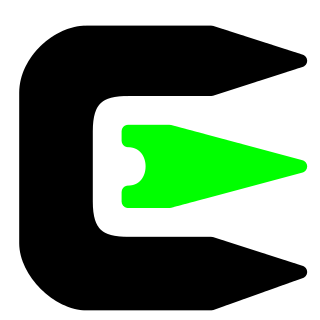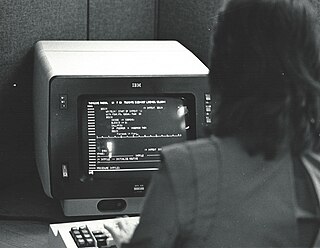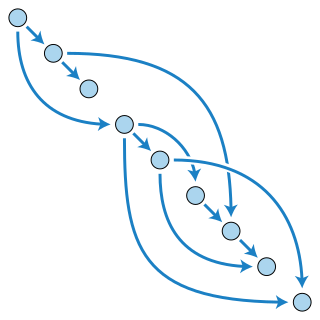In computing and telecommunication, a control character or non-printing character (NPC) is a code point in a character set, that does not represent a written symbol. They are used as in-band signaling to cause effects other than the addition of a symbol to the text. All other characters are mainly printing, printable, or graphic characters, except perhaps for the "space" character.

Cygwin is a POSIX-compatible environment that runs natively on Microsoft Windows. Its goal is to allow programs of Unix-like systems to be recompiled and run natively on Windows with minimal source code modifications by providing them with the same underlying POSIX API they would expect in those systems.

The IBM 3270 is a class of block oriented computer terminals introduced by IBM in 1971 normally used to communicate with IBM mainframes. The 3270 was the successor to the IBM 2260 display terminal. Due to the text colour on the original models, these terminals are informally known as green screen terminals. Unlike a character-oriented terminal, the 3270 minimizes the number of I/O interrupts required by transferring large blocks of data known as data streams, and uses a high speed proprietary communications interface, using coaxial cable.
A relational database is a digital database based on the relational model of data, as proposed by E. F. Codd in 1970. A software system used to maintain relational databases is a relational database management system (RDBMS). Virtually all relational database systems use SQL for querying and maintaining the database.
In computing and telecommunication, an escape character is a character which invokes an alternative interpretation on subsequent characters in a character sequence. An escape character is a particular case of metacharacters. Generally, the judgment of whether something is an escape character or not depends on context.
An escape sequence is a combination of characters that has a meaning other than the literal characters contained therein; it is marked by one or more preceding characters.
An environment variable is a dynamic-named value that can affect the way running processes will behave on a computer.
Panoramic photography is a technique of photography, using specialized equipment or software, that captures images with horizontally elongated fields of view. It is sometimes known as wide format photography. The term has also been applied to a photograph that is cropped to a relatively wide aspect ratio, like the familiar letterbox format in wide-screen video.

Automatic Packet Reporting System (APRS) is an amateur radio-based system for real time digital communications of information of immediate value in the local area. Data can include object Global Positioning System (GPS) coordinates, weather station telemetry, text messages, announcements, queries, and other telemetry. APRS data can be displayed on a map, which can show stations, objects, tracks of moving objects, weather stations, search and rescue data, and direction finding data.
In biology, an identification key is a printed or computer-aided device that aids the identification of biological entities, such as plants, animals, fossils, microorganisms, and pollen grains. Identification keys are also used in many other scientific and technical fields to identify various kinds of entities, such as diseases, soil types, minerals, or archaeological and anthropological artifacts.

SmartMedia is a flash memory card standard owned by Toshiba, with capacities ranging from 2 MB to 128 MB. SmartMedia memory cards are no longer manufactured.
Evolutionary taxonomy, evolutionary systematics or Darwinian classification is a branch of biological classification that seeks to classify organisms using a combination of phylogenetic relationship, progenitor-descendant relationship, and degree of evolutionary change. This type of taxonomy may consider whole taxa rather than single species, so that groups of species can be inferred as giving rise to new groups. The concept found its most well-known form in the modern evolutionary synthesis of the early 1940s.
The Hauppauge MediaMVP is a network media player. It consists of a hardware unit with remote control, along with software for a Windows PC. Out of the box, it is capable of playing video and audio, displaying pictures, and "tuning in" to Internet radio stations. Alternative software is also available to extend its capabilities. It can be used as a front-end for various PVR projects.

Raw data, also known as primary data, is data collected from a source. If a scientist sets up a computerized thermometer which records the temperature of a chemical mixture in a test tube every minute, the list of temperature readings for every minute, as printed out on a spreadsheet or viewed on a computer screen is "raw data". Raw data has not been subjected to processing, "cleaning" by researchers to remove outliers, obvious instrument reading errors or data entry errors, or any analysis. As well, raw data has not been subject to any other manipulation by a software program or a human researcher, analyst or technician. It is also referred to as primary data. Raw data is a relative term, because even once raw data has been "cleaned" and processed by one team of researchers, another team may consider this processed data to be "raw data" for another stage of research. Raw data can be inputted to a computer program or used in manual procedures such as analyzing statistics from a survey. The term "raw data" can refer to the binary data on electronic storage devices, such as hard disk drives.

The Osborne Executive was the planned successor of the already commercially successful Osborne 1 portable computer by Osborne Computer Corporation. The Executive was a collection of the good features from the Osborne 1 and fixed some of its predecessor's flaws.

Sixel, short for "six pixels", is a bitmap graphics format supported by terminals and printers from DEC. It consists of a pattern six pixels high and one wide, resulting in 64 possible patterns. Each possible pattern is assigned an ASCII character, making the sixels easy to transmit on 7-bit serial links.

Identification in biology is the process of assigning a pre-existing taxon name to an individual organism. Identification of organisms to individual scientific names may be based on individualistic natural body features, experimentally created individual markers, or natural individualistic molecular markers. Individual identification is used in ecology, wildlife management and conservation biology. The more common form of identification is the identification of organisms to common names or scientific name. By necessity this is based on inherited features ("characters") of the sexual organisms, the inheritance forming the basis of defining a class. The features may, e. g., be morphological, anatomical, physiological, behavioral, or molecular.
Psychometric software is software that is used for psychometric analysis of data from tests, questionnaires, or inventories reflecting latent psychoeducational variables. While some psychometric analyses can be performed with standard statistical software like SPSS, most analyses require specialized tools.
In computing and telecommunications, the capabilities of a terminal are various terminal features, above and beyond what is available from a pure teletypewriter, that host systems can make use of. They are (mainly) of control codes and escape codes that can be sent to or received from the terminal. The escape codes sent to the terminal perform various functions that a CRT terminal is capable of, but that a teletypewriter is not; such as moving the terminal's cursor to positions on the screen, clearing and scrolling all or parts of the screen, turning on and off attached printer devices, programming programmable function keys, changing display colours and attributes, and setting display title strings. The escape codes received from the terminal signify things such as function key, arrow key, and other special key keystrokes.









